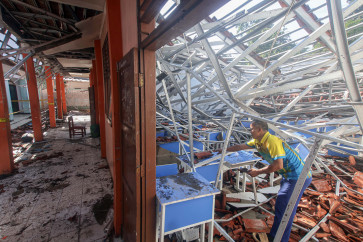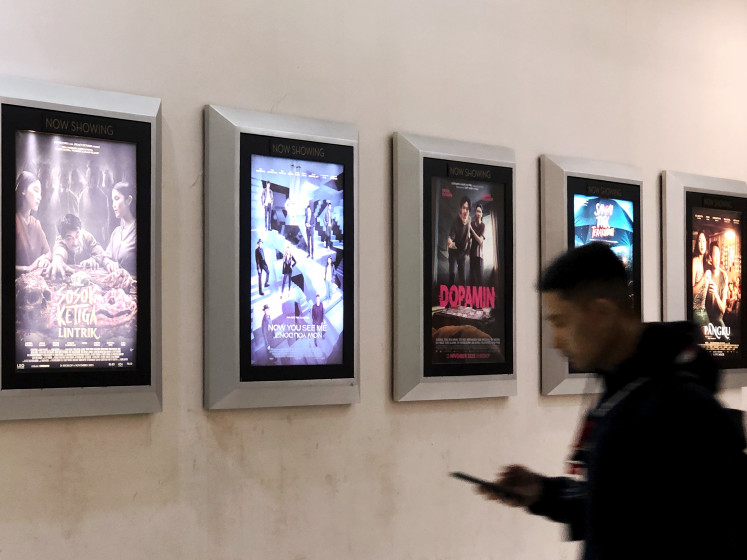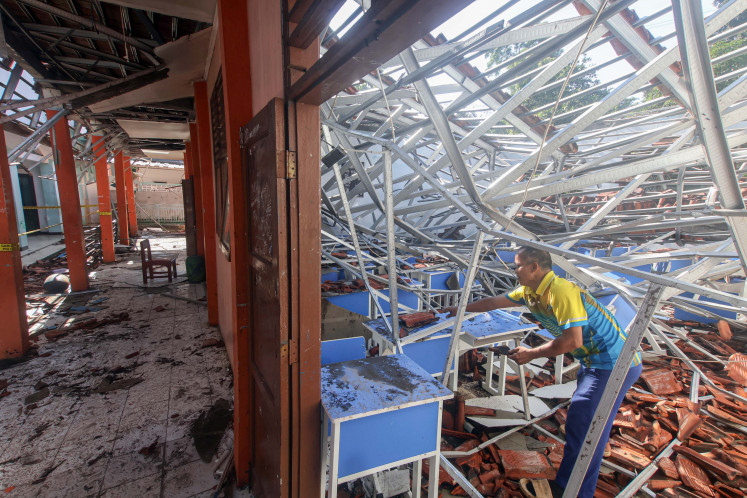Popular Reads
Top Results
Can't find what you're looking for?
View all search resultsPopular Reads
Top Results
Can't find what you're looking for?
View all search resultsGovernment looks to revamp fisheries policies in Natuna
Almost seaworthy: A shipwright works on a wooden motorized vessel in Tanjung village, Natuna, Riau Islands, on Tuesday
Change text size
Gift Premium Articles
to Anyone
A
lmost seaworthy: A shipwright works on a wooden motorized vessel in Tanjung village, Natuna, Riau Islands, on Tuesday. The ship, which will have a capacity of 30 to 40 gross tons, is expected to be completed in about four months and cost Rp 150 million (US$11,000). (Antara/M Risyal Hidayat)
The government is planning to revise various existing fisheries policies concerning waters around Natuna, including by rebranding the controversial cantrang (seine nets), while also seeking to strengthen the Maritime Security Agency (Bakamla), a senior minister has said.
As Chinese vessels left Indonesia's exclusive economic zone (EEZ) in the North Natuna Sea after a standoff lasting a few weeks, officials began talking about Indonesia increasing its presence in the waters on the southernmost edge of the highly disputed South China Sea and making the most of its fishing grounds.
Coordinating Maritime Affairs and Investment Minister Luhut Pandjaitan said Bakamla would take the lead on law enforcement in the waters, which would be regulated in the upcoming omnibus law on maritime security currently being drafted by the Coordinating Political, Legal and Security Affairs Ministry.
Both Luhut's office and the Maritime Affairs and Fisheries Ministry are now also conducting studies — including on the use of cantrang in certain places, such as in the Natuna EEZ — which, according to Luhut, would be used as a basis for future fisheries policies in Natuna.
Cantrang have been identified by many experts as destructive to coral reefs and the seabed ecosystem.
“The study that we are working on will answer every concern. We and the Maritime Affairs and Fisheries Ministry will listen to everyone,” Luhut said.
Unlike similar skirmishes in 2016, Indonesia now faces Chinese incursions into Natuna without the stern approach of former maritime affairs and fisheries minister Susi Pudjiastuti, who gained a reputation for sinking vessels found fishing illegally in Indonesian waters, a policy seen by many as an effective deterrent. Her successor Edhy Prabowo has said he will not continue the policy.
Luhut said he and Edhy had instructed their staff to find a better solution, even though reports showed that Susi’s policy resulted in a drop of more than 90 percent in foreign poaching in Indonesian waters.
”There have never been any studies [on fisheries policy] but now we are conducting some, and based on those we will make the necessary policy,” Luhut said. “This has nothing to do with who is the minister. Everything that we do should be based on comprehensive study; it’s nothing personal,” he added.
Luhut's acting deputy for maritime resources Safri Burhanuddin said another issue being discussed was how to transport hundreds of Javanese fisherfolk, who own bigger fishing vessels than their Natuna counterparts and have expressed their readiness to go north and fish in the North Natuna Sea.
The problem, he said, was the lack of facilities to sustain such a large vessel, including refueling and cold storage facilities, as well as a fish market to export the fish to interested countries such as Japan and South Korea.
Furthermore, Safri said local Natuna fishermen opposed the use of cantrang and therefore, they could not compete with most foreign fishing vessels that encroached on Indonesia’s waters using trawling nets, which have similar mechanism to cantrang.
“This is just a naming issue, so we’re thinking about finding a new term, changing it from cantrang to trawler,” he said, adding that what was left in North Natuna waters were mostly demersal (bottom feeding) fish, as opposed to pelagic fish, which were relatively depleted.
He said only trawling nets could reach demersal fish, and the use of cantrang in Natuna's EEZ was feasible because, unlike the Java Sea, the bottom of the North Natuna Sea did not contain much coral reef, except near the islands.
Indonesia Ocean Justice Initiative chief executive officer Mas Achmad Santosa, formerly Susi’s point man on her anti-illegal fishing campaign, said Natuna should not be an exception to the use of trawling nets just because the government aimed to increase its presence there.
“If other people harm [the environment], it doesn’t mean we should too. Trawling nets are not sustainable equipment and the North Natuna Sea already suffers from chronic overfishing. Our next generation will be at risk,” he said recently.
According to data from the Asia Maritime Transparency Initiative (AMTI), fish stocks in the South China Sea are collapsing, with the total population of fish having been depleted by 70 to 95 percent since the 1950s and catch rates having declined by 66 to 75 percent over the last 20 years.










